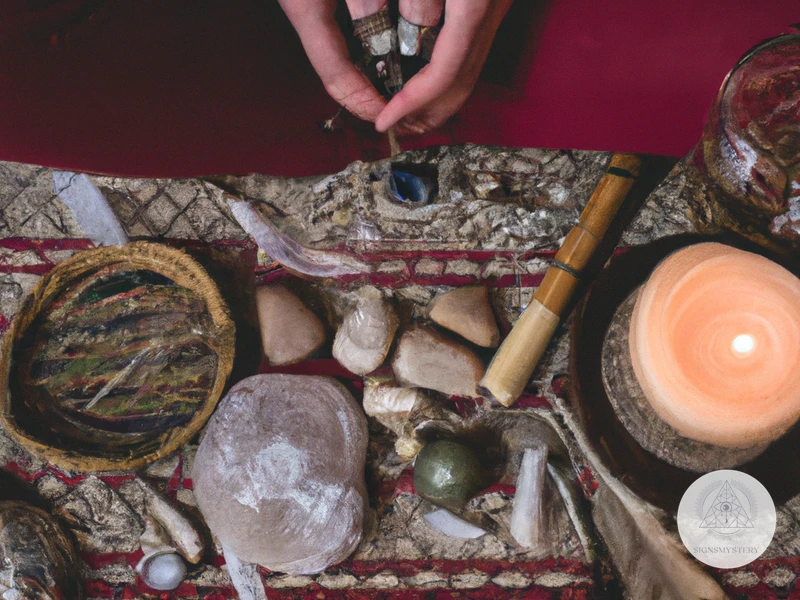Shamanic journeying has been practiced for centuries by indigenous cultures around the world as a means of connecting with the spirit world for personal growth, healing, and guidance. But as the practice gains popularity in mainstream culture, the benefits and risks of shamanic journeying can be both intriguing and confusing. What is shamanic journeying, exactly? How does it work? And what are the potential risks involved? In this article, we’ll dive into the world of shamanic journeying, exploring its many benefits and also delving into the potential dangers that can arise when working with altered states of consciousness. Whether you’re curious about shamanic journeying or you’re a seasoned practitioner, this guide will provide valuable insights and practical tips for navigating this powerful practice with safety and intentionality.
The Benefits of Shamanic Journeying

One of the main benefits of shamanic journeying is the opportunity it provides for spiritual growth and self-discovery. Through this practice, individuals are able to access different realms of consciousness and connect with their inner selves and spirit guides. Shamanic journeying can also be a powerful tool for healing, as it allows individuals to access the root cause of their physical, mental, and emotional issues. Journeying can bring a heightened sense of connection to the spirit world, allowing individuals to receive guidance and support from their ancestors and other spiritual entities. To learn more about shamanic journeying, check out our article on Understanding Shamanic Journeying.
1. Spiritual Growth and Self-Discovery
Shamanic journeying is known to bring about deep spiritual growth and self-discovery. It allows individuals to explore their inner selves, connect with the spirit realm, and receive guidance and wisdom for their personal growth. During a shamanic journey, participants may experience a sense of unity with the universe, access to higher dimensions of consciousness, and a closer connection to their true essence.
Through shamanic journeying, individuals can gain a better understanding of themselves and their purpose in life. They can tap into their subconscious mind, face their fears and limitations, and discover their hidden talents and strengths. This can help them gain clarity and direction in life, and make more conscious decisions that align with their true self.
Moreover, a shamanic journey can provide a powerful tool for healing emotional wounds and traumas. It can help individuals release negative emotions and patterns and replace them with positive beliefs and intentions. By connecting with their inner healer and spirit guides, individuals can receive guidance and support in their healing process and experience a profound sense of inner peace and harmony.
However, it is important to note that shamanic journeying is not a substitute for professional therapy or medical treatment. It should be approached with caution, and individuals should seek the guidance of a qualified shamanic practitioner and follow safety guidelines to avoid potential risks.
If you want to learn more about shamanic journeying and its role in traditional cultures, check our article about shamanic journeying in traditional cultures. Or if you are interested in preparing for a shamanic journey, go to our article on preparing for shamanic journey to learn more.
2. Healing and Wellness
Shamanic journeying is a powerful practice that has been used for thousands of years to promote healing and wellness. In today’s modern world, many people are turning to shamanic journeying as a way to address physical, emotional, and spiritual imbalances. Here are some of the ways that shamanic journeying can support healing and wellness:
1. Accessing Inner Wisdom: Through shamanic journeying, you can tap into your own inner wisdom and guidance, accessing information that is not available to you through your conscious mind. This can provide insight into challenges you may be facing and offer guidance on how to move forward.
2. Identifying and Clearing Blockages: Shamanic journeying can be used to identify areas of your energy system where there may be blockages or disruptions. By identifying these areas, you can then work to clear them, promoting better flow and balance throughout your body.
3. Releasing Emotional Trauma: Shamanic journeying can also be a powerful tool for addressing emotional trauma. By revisiting past experiences and working with the support of your spirit guides, you can release old wounds and emotions that may be holding you back from living your fullest life.
4. Connecting with Ancestors and Guides: Through shamanic journeying, you can connect with your ancestors and spiritual guides, who can offer support and guidance on your journey toward healing and wellness.
5. Integrating Mind, Body, and Spirit: Shamanic journeying is a holistic practice that can help you integrate all aspects of yourself, promoting greater alignment between your mind, body, and spirit.
If you’re interested in trying shamanic journeying for yourself, there are many resources available to help you get started. You may want to explore techniques for beginners or consider embarking on a specific journey, such as a lower world or power animal journey. Whatever path you choose, remember that shamanic journeying can be a powerful tool for promoting healing and wellness, and should be approached with care and intention.
3. Connection to the Spirit World
Shamanic journeying has been used for centuries to connect with the spirit world. Through this practice, an individual can connect with their power animal, spirit guide, ancestors, and other spiritual beings. This connection can bring about many benefits, including insight and guidance on one’s life path.
One of the primary benefits of connecting to the spirit world is gaining a deeper understanding of oneself and one’s purpose in life. This understanding can lead to greater contentment and a sense of fulfillment in life. Some people also believe that connecting with the spirit world can lead to increased intuition and psychic abilities.
Another common benefit of connecting to the spirit world is receiving guidance and wisdom from spiritual beings. These beings can offer insight into one’s life challenges or provide guidance on decision-making. Some people find this guidance to be incredibly helpful in navigating life’s complexities.
It’s important to note, however, that connecting to the spirit world can also pose risks. Individuals who are not prepared or don’t take precautions may encounter negative spiritual interactions. This can include encountering lower vibrational entities or becoming spiritually lost. It’s essential to work with a qualified shamanic practitioner and take steps to create a safe and sacred space before embarking on a shamanic journey.
Connecting with the spirit world through shamanic journeying can offer many benefits. It can bring clarity and guidance to one’s life path, deepen one’s understanding of oneself, and provide access to wisdom from spiritual beings. However, it’s important to be aware of the risks and take necessary precautions to ensure the safety of the journey.
If you’re new to shamanic journeying, check out our article on shamanic journeying techniques for beginners and learn how to start your own journey. You can also read about lower world shamanic journey and encountering power animals in shamanic journeys to get a better understanding of what to expect during your journey, or learn about the benefits of healing shamanic journeys and connecting with ancestors and guides for more ways to connect with the spirit world.
The Risks of Shamanic Journeying
Shamanic journeying can have risks, and it is essential to understand them before embarking on the practice. One of the psychological risks of shamanic journeying is experiencing overwhelming emotions that can cause discomfort and distress. Another risk is that the experience may bring to the surface past traumas or unresolved issues, leading to a temporary increase in symptoms such as anxiety or depression. In terms of safety concerns, physically moving while in a journey trance state can lead to injuries or accidents. Additionally, negative spiritual interactions can occur when dealing with entities or energies that are not benevolent. It is crucial to find a qualified shamanic practitioner, set intentions, and create a safe space before beginning the journey to reduce these risks. It is also important to trust one’s inner guidance when navigating difficult moments during the experience, and to practice grounding and self-care afterward to integrate and reflect on the journey’s lessons.
1. Psychological Risks
Shamanic journeying can be a powerful tool for personal growth and spiritual development, but like any practice, it does come with potential risks. One area of concern is the potential psychological risks associated with shamanic journeying.
One of the primary psychological risks of shamanic journeying is experiencing overwhelming emotions or memories. During a journey, individuals may access deep-seated emotions or traumatic memories that they may not be ready to confront. This can lead to feelings of fear, anxiety, or even panic. Additionally, some individuals may experience dissociation or depersonalization, feeling as though they are detached from their body or reality.
Another psychological risk is the potential for re-traumatization. If an individual has experienced trauma in the past, certain events or sensations during a journey may trigger memories or emotions associated with that trauma. This can be highly distressing and even potentially harmful to the individual’s mental and emotional health.
It’s also important to note that shamanic journeying can sometimes exacerbate existing mental health conditions. Those with a history of mental illness, particularly conditions such as bipolar disorder or schizophrenia, may be at greater risk for experiencing negative side effects from shamanic journeying.
To minimize the risk of psychological harm, it’s essential for individuals considering shamanic journeying to work with a qualified practitioner who can provide support and guidance throughout the process. Practitioners can help individuals process emotional experiences and provide insight into any potential triggers.
While the psychological risks of shamanic journeying should be taken seriously, they can be minimized through careful preparation and guidance from a qualified practitioner. It’s important for individuals to approach the practice with openness and mindfulness, and to prioritize their own mental and emotional well-being throughout the journeying process.
2. Safety Concerns
Safety Concerns
While shamanic journeying can be a powerful and transformative experience, it’s important to be aware of the potential safety concerns. One of the main risks of shamanic journeying is that it can sometimes bring up intense emotions or traumatic memories. This can be overwhelming, especially for individuals who are not equipped to handle these feelings. It’s important to practice shamanic journeying only under the guidance of a trained and experienced shamanic practitioner.
Another safety concern is related to physical safety. During a shamanic journey, one can become so deeply immersed in the experience that they may lose their sense of surroundings or even forget where they are. This can lead to accidents or injuries, especially if the journey is taking place in an unfamiliar or unsafe environment. It’s important to create a safe and comfortable space before beginning a shamanic journey.
Lastly, it’s important to be aware of the potential risks involved in interacting with spiritual entities during a shamanic journey. It’s important to remember that not all entities encountered on a shamanic journey may have positive intentions. Some may be tricksters or may even have harmful intentions towards the individual. It’s crucial to always approach any spiritual interaction with caution and respect.
In order to minimize these safety concerns, it’s essential to follow the guidance of a qualified shamanic practitioner and to prepare carefully before beginning a journey. This means creating a safe environment, setting intentions, and practicing grounding and centering techniques. By taking these precautions, individuals can reduce the risk of experiencing negative consequences and ensure that their shamanic journey is a positive and transformative experience.
3. Negative Spiritual Interactions
While shamanic journeying can bring about many positive experiences, there is also a potential for negative spiritual interactions. This can occur when journeying into the spiritual realm without proper guidance or protection.
Negative spiritual interactions can take on many forms, such as encountering malevolent spirits or energies that can cause harm or lead to negative psychological effects. These interactions can also occur when the practitioner is not properly grounded or protected, leaving them susceptible to negative energy.
It is important to note that these negative interactions are not common and can often be avoided by following proper precautions and working with an experienced practitioner. However, if you do encounter negative energy or spirits during a journey, there are steps you can take to protect yourself and end the experience.
One technique that can be used is setting an intention before the journey to only connect with positive energy and spirits. This can help to ward off any negative interactions that may occur. Additionally, having a physical object such as a crystal or protective amulet can also offer added protection.
It is also important to have a plan in place for ending the journey if negative interactions do occur. This may include grounding exercises or visualization techniques to help bring the practitioner back to their physical body and end the journey safely.
Negative spiritual interactions are a potential risk when practicing shamanic journeying. However, by working with a qualified practitioner and taking proper precautions, practitioners can minimize the risk and focus on the many benefits shamanic journeying can offer.
Preparing for a Shamanic Journey

Preparing for a shamanic journey involves several important steps to ensure a safe and transformative experience. The first step is to find a qualified shamanic practitioner who can guide you through the journey. This can be done through research and referrals from trusted sources. Once you have found a practitioner, it is important to set intentions for the journey. This involves identifying what you hope to gain from the experience and what issues or concerns you would like to address. Creating a safe and sacred space is also crucial for a successful journey. This can be done by preparing the physical space with items such as candles, crystals, and essential oils, as well as setting boundaries around the time and duration of the journey. By taking these steps and approaching the journey with an open mind and heart, individuals can access the profound spiritual growth and self-discovery that shamanic journeying can offer.
1. Finding a Qualified Shamanic Practitioner
When it comes to shamanic journeying, finding a qualified practitioner is essential for a safe and effective experience. Here are some factors to consider when searching for a practitioner:
| Factor | Description |
| Training and Certification | Look for a practitioner who has completed formal training and received a certification in shamanic practices. This ensures that they have a solid understanding of the techniques and safety protocols involved. |
| Experience | Find out how long the practitioner has been practicing shamanic journeying and if they have experience working with people who have similar concerns or intentions as you. This can help ensure that they have the necessary skills to guide you through the journey. |
| References and Reviews | Ask for references or read online reviews from previous clients. This can give you an idea of the practitioner’s reputation and success rate. |
| Professional Boundaries | Make sure the practitioner maintains professional boundaries throughout the journey and does not engage in any inappropriate behavior. If you feel uncomfortable or unsafe at any point, it’s important to communicate this to the practitioner and discontinue the session. |
By taking these factors into consideration, you can increase your chances of finding a qualified shamanic practitioner who can guide you through a safe and transformative journey.
2. Setting Intentions
When embarking on a shamanic journey, it is essential to set clear and intentional intentions for the experience. Your intentions will act as a guidepost for your journey and help to focus your energy and attention. Before beginning, take time to reflect on what you hope to achieve or what questions you would like answered during your journey.
To set your intentions, find a quiet space where you will not be disturbed. Take a few deep breaths to center and ground yourself. You may want to light a candle or burn sage to create a sacred space. Then, begin to formulate your intentions. Be clear and specific. For example, you might set an intention to connect with your spirit guides or to receive clarity and guidance on a particular issue in your life.
Once you have set your intentions, it can be helpful to write them down in a journal or on a piece of paper that you can take with you to your journey. This will help to reinforce your intentions and provide a visual reminder of what you hope to achieve.
Remember, your intentions can be revised and refined as needed. Trust your intuition and listen to your inner voice. Your intentions may evolve as you continue to work with shamanic journeying and gain insight and clarity. Stay open to the possibilities and allow yourself to be guided by the wisdom of the journey. With clear intentions, you will be better equipped to navigate the experience and receive the full benefits of shamanic journeying.
3. Creating a Safe and Sacred Space
Creating a safe and sacred space is crucial before embarking on a shamanic journey. This space should provide a feeling of security, tranquility, and a connection to higher spiritual forces. There are several ways to achieve this:
Cleanse the Space: Start by cleansing the physical environment where the journey will take place. Use sage, palo santo, or other smudging herbs to clear any negative energy that may be present. This will create a fresh and open space for the journey.
Add Intentional Items: Choose items to add to the space that have personal or spiritual significance. This can include crystals, feathers, candles, or other items that cultivate your connection to spirit. These items will help to reinforce the intention of the journey.
Create a Comfortable Space: Ensure that the physical space is comfortable for the journeyer. This can include cushions, blankets, or any other items that will enhance their comfort during the journey. Creating a comfortable space will allow the journeyer to relax and fully surrender to the experience.
Silence and Privacy: Establishing quietness and a sense of privacy is also essential. Turn off all phones and other devices that may disrupt the space. Additionally, ensure that there is no risk of being interrupted or disturbed during the journey.
Creating a safe and sacred space is a vital part of the shamanic journeying process. Doing so will help to enhance the journeyer’s experience and allow them to fully open up to the spiritual realm.
During the Journey
As you embark on a shamanic journey, it’s essential to remember that surrendering to the experience is crucial. Let go of control and trust the journey to take you where you need to go. Navigating challenging moments can be challenging, but it’s important to remind yourself that you are safe and supported. Call on your spirit guides and ancestors to help guide you through any difficulties that arise. Trusting your inner guidance is key. Pay attention to any intuitive hits or messages that come through during the journey, as they can offer valuable insights and guidance for your life. If you’re feeling overwhelmed, take deep breaths and remember to ground yourself in the present moment. Let the journey unfold naturally, and trust that
Subscribe to Our Newsletter
Sign up to receive the latest news and updates.
1. Surrendering to the Experience
When embarking on a shamanic journey, it’s important to surrender completely to the experience. This means letting go of any expectations or preconceived notions and allowing yourself to be fully immersed in the journey.
Surrendering to the experience involves letting go of the need to control what’s happening and trusting that the journey will take you where you need to go. It’s important to remember that the journey is not a conscious experience, and you should try to let go of any mental or emotional attachments.
To surrender, begin by focusing on your breath and allowing yourself to become relaxed and centered. As you journey, try to remain open and receptive to any messages or insights that may come through. Don’t try to force anything or push the experience in any specific direction.
Surrendering does not mean losing control or putting yourself in harm’s way. It’s important to maintain a sense of awareness and grounding throughout the journey. Trust that your inner guidance will keep you safe and guide you towards what you need to experience.
Remember that surrendering to the experience does not mean you are powerless. You still have the ability to set intentions and redirect the journey if necessary. However, try to avoid interfering too much with the experience and instead allow it to unfold naturally.
By surrendering to the experience, you allow yourself to truly connect with the spirit world and receive the messages and insights that you need for your growth and healing. Trust in the process and know that the journey will guide you towards what you need in that moment.
2. Navigating Challenging Moments
Navigating challenging moments during a shamanic journey can be a pivotal part of the experience. It is not uncommon to encounter intense emotions or unexpected obstacles while in an altered state of consciousness. However, these moments can also provide valuable insights and healing opportunities if approached with openness and acceptance.
Below are some tips for navigating challenging moments during a shamanic journey:
| Tip | Description |
|---|---|
| 1. Remember your intention | Reconnecting with the intention you set before the journey can provide guidance and focus during difficult moments. Remind yourself of why you are here and what you hope to gain from the experience. |
| 2. Lean into the discomfort | Instead of resisting or avoiding uncomfortable emotions or sensations, try to lean into them and explore what they have to teach you. This can be difficult, but the rewards can be profound. |
| 3. Call on your spiritual guides | If you encounter a particularly challenging moment, call on your spiritual guides for assistance and support. Ask for their guidance and trust that they will help lead you through the experience. |
| 4. Use breath and visualization techniques | Deep breathing and visualization can be powerful tools for calming the mind and shifting your focus away from fear or discomfort. Try imagining yourself surrounded by a protective bubble of light or picturing a peaceful scene to help bring a sense of calm. |
| 5. Remember that you are in control | Even in an altered state of consciousness, you are ultimately in control of your experience. If at any point you feel unsafe or overwhelmed, you can take a step back or ask your shamanic practitioner for assistance. |
Remember that challenging moments during a shamanic journey are a normal part of the process and can provide valuable insights and healing opportunities. Trust in yourself and your spiritual guides to navigate these moments with grace and openness.
3. Trusting Your Inner Guidance
Trusting your inner guidance is an essential part of shamanic journeying. It is not uncommon for individuals to doubt their ability to navigate the spiritual realm or dismiss their intuitive impressions. However, learning to trust and rely on your inner guidance is crucial for a successful shamanic journey.
Here are three ways to build trust in your inner guidance during a shamanic journey:
1. Let go of rational thinking: During shamanic journeying, you will encounter messages, symbols and visions that may not make sense rationally. It is important to let go of rational thinking and allow the symbols and messages to reveal their true meanings to you. Trying to understand everything logically will only hinder your spiritual growth and prevent you from tapping into your higher consciousness.
2. Pay attention to your emotions: Your emotions are powerful indicators of your inner guidance. Pay attention to how you feel during your shamanic journeying experience. Your emotions will guide you towards what is working and what needs to change within yourself. If you feel heavy and sad, it may be a sign that you are holding onto negative emotions that need to be released. If you feel light and joyful, it may be a sign that you are on the right path towards spiritual growth.
Here is a list of positive affirmations to help build trust in your inner guidance during shamanic journeying:
- I trust in my inner guidance to show me the way.
- I am open to receiving spiritual messages and insights.
- My intuition is powerful and accurate.
- My emotions guide me towards what is best for my spiritual growth.
- I release the need to control and surrender to the guidance of my higher self.
3. Keep a journal: Keeping a journal is an excellent way to document your shamanic journeys and the messages received, allowing you to track patterns and gain insights into your spiritual growth. Write down any symbols, visions or messages received during the journey, and how they made you feel. Over time, you will see how these insights relate to your daily life and spiritual path.
Trusting your inner guidance during a shamanic journey takes time and practice. However, it is an essential component of spiritual growth and personal development. By letting go of rational thinking, paying attention to your emotions, and keeping a journal, you can build trust in your inner guidance and deepen the connection with your higher self.
After the Journey
After a shamanic journey, it’s important to take time for reflection and integration of the experience. Integration can be done through journaling, meditation, or talking with a trusted friend or shamanic practitioner. It’s important to recognize the impact that the journey may have had on your emotions, thoughts, and physical body. Grounding practices such as walking in nature, taking a warm bath, or doing gentle yoga can also help bring you back to the present moment. Continuing with self-care practices, such as a healthy diet and regular exercise, can aid in sustaining the benefits of the shamanic journey. Remember to be patient with the integration process, as it may take time to fully understand the insights gained during the journey.
1. Integration and Reflection
After completing a shamanic journey, it can be helpful to take some time for integration and reflection. This allows you to process and make sense of any insights or experiences you may have had during the journey.
One way to integrate is to journal about your experience. Write down any vivid images, messages, or sensations you remember from the journey. Reflect on what they might mean for you in your daily life. Notice any patterns or connections between your journey and current challenges or goals.
It can also be helpful to share your experience with a trusted friend or therapist who is knowledgeable about shamanism. Talking about your journey can deepen your understanding of it and help you integrate it into your life.
In addition to reflection and conversation, physical practices can help with integration and grounding. Yoga, meditation, or time spent in nature can help you feel more centered and connected after a journey.
The most important aspect of integration and reflection is to be kind and compassionate with yourself. Remember that a shamanic journey can be a powerful experience, and it may take time for you to fully understand its impact. Be patient and open to whatever arises as you continue on your healing and spiritual journey.
2. Grounding Practices
Grounding practices are an essential part of the shamanic journeying experience, helping individuals to integrate and anchor their experiences into their physical bodies and daily lives. There are several techniques to ground oneself after a journey, including deep breathing exercises, yoga, and walking in nature.
Deep breathing exercises are a simple but effective way to ground oneself after a shamanic journey. This involves taking slow, deep breaths from the abdomen, holding for a few seconds, and then exhaling slowly. This technique helps to release any residual energy and emotions, and reconnects individuals with their physical bodies. If done regularly, deep breathing can also help reduce stress and anxiety.
Yoga is another powerful grounding practice that harmonizes the mind, body, and spirit. Yoga poses such as Tree pose or Mountain pose help to connect individuals with the earth, while also promoting balance, strength, and flexibility. Yoga also involves conscious breathing, which helps to calm the mind and bring individuals back to the present moment.
Walking in nature is also an excellent grounding practice after a shamanic journey. Nature has a profound ability to help individuals reconnect with their physical bodies and the natural rhythms of the earth. Walking barefoot or sitting with one’s back against a tree helps to establish a deeper connection with the earth, while also promoting mindfulness and relaxation.
Other grounding practices include meditation, mindful eating, and creating art. Ultimately, the goal of these practices is to help individuals integrate the wisdom and insights gained during their shamanic journey and apply them to their daily lives. Grounding practices can provide a sense of balance, clarity, and empowerment, helping individuals to live more fully in the present moment.
3. Continued Self-Care
3. Continued Self-Care
After completing a shamanic journey, it is important to continue practicing self-care to integrate the experience into your everyday life. Here are some ways to take care of yourself post-journey:
- Rest: Give yourself plenty of time to rest and recover after the journey. Shamanic journeys can be intense experiences that require time to process.
- Journaling: Write down your thoughts, feelings, and any insights you gained during the journey. This can help you reflect on the experience and remember key takeaways.
- Meditation: Continue to meditate to help you integrate the journey into your daily life. Meditation can also help you stay connected to your inner guidance and spiritual practices.
- Exercise: Engage in gentle physical activity to help your body release any remaining tension or energy from the experience. Yoga, tai chi, or walking in nature can be excellent ways to stay grounded and centered.
- Connect with others: Share your journey experience with others who support and understand shamanic practices. This can help you process the experience and feel validated.
Remember that the integration process can take time and be a deeply personal journey. Be patient with yourself and trust the process. If you are struggling with any challenges or negative effects post-journey, do not hesitate to reach out to a qualified shamanic practitioner or mental health professional for support.
Conclusion
In conclusion, shamanic journeying can provide many benefits such as spiritual growth, self-discovery, healing, and connection to the spirit world. It can be an incredibly powerful tool for personal transformation when approached with respect and guidance from a qualified shamanic practitioner. However, it is important to recognize the potential risks involved, including psychological risks and safety concerns.
It is crucial to properly prepare for a shamanic journey by finding a qualified practitioner and creating a safe and sacred space. During the journey, surrendering to the experience, navigating challenging moments, and trusting your inner guidance can help you gain the most from the journey. After the journey, integration and reflection, grounding practices, and continued self-care can help you further incorporate the insights gained from the experience into your daily life.
Remember that shamanic journeying is not a quick fix or a one-time cure-all. It is a journey that requires ongoing dedication and effort to fully realize the benefits it can offer. With proper preparation, guidance, and self-care, shamanic journeying can be a transformative and enlightening experience. Consider exploring this powerful technique for personal growth and spiritual connection under the guidance of a qualified practitioner.
Frequently Asked Questions
What is shamanic journeying?
Shamanic journeying is a practice in which an individual enters an altered state of consciousness to connect with the spirit world and receive guidance and wisdom.
What are some benefits of shamanic journeying?
Shamanic journeying can offer benefits such as spiritual growth, self-discovery, healing and wellness, and connection to the spirit world. It can help promote personal growth and insight.
Are there any risks associated with shamanic journeying?
Yes, there are risks involved in shamanic journeying. These can include psychological risks, safety concerns, and negative spiritual interactions. It is important to prepare properly and work with a qualified shamanic practitioner to minimize these risks.
What is a shamanic practitioner?
A shamanic practitioner is someone who has been trained in the art of shamanic journeying and who helps facilitate the practice for others. They are experienced in guiding individuals through the process and are knowledgeable about potential risks and how to minimize them.
How do I prepare for a shamanic journey?
Preparing for a shamanic journey involves finding a qualified shamanic practitioner, setting intentions, and creating a safe and sacred space. It is important to be in a peaceful and calm state of mind before beginning the journey.
What happens during the shamanic journey?
During a shamanic journey, an individual enters an altered state of consciousness and travels to the spirit world. They may encounter spirit guides, receive messages or wisdom, or experience transformative visions or healing.
Is it possible to have a negative experience during a shamanic journey?
Yes, it is possible to have a challenging or negative experience during a shamanic journey. This can include encountering difficult emotions or experiences, feeling overwhelmed or lost, or experiencing negative spiritual interactions. Working with a qualified shamanic practitioner can help mitigate these risks.
What should I do after a shamanic journey?
After a shamanic journey, it is important to take time to integrate and reflect on the experience. Grounding practices such as meditation or spending time in nature can also be beneficial. Continued self-care following the journey is also important.
Can anyone participate in shamanic journeying?
While anyone can participate in shamanic journeying, it is important to work with a qualified shamanic practitioner and to prepare properly. Individuals with a history of trauma or mental health issues should approach the practice with caution and may want to consult their healthcare provider before participating.
How does shamanic journeying differ from other spiritual practices?
Shamanic journeying differs from other spiritual practices in that it involves entering an altered state of consciousness to connect with the spirit world. It is a practice that has been used for thousands of years in cultures around the world and is often used for healing and personal growth.










